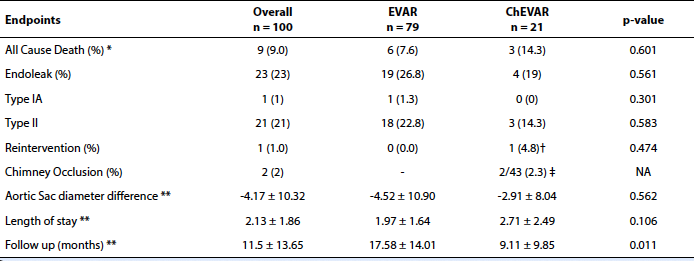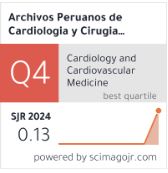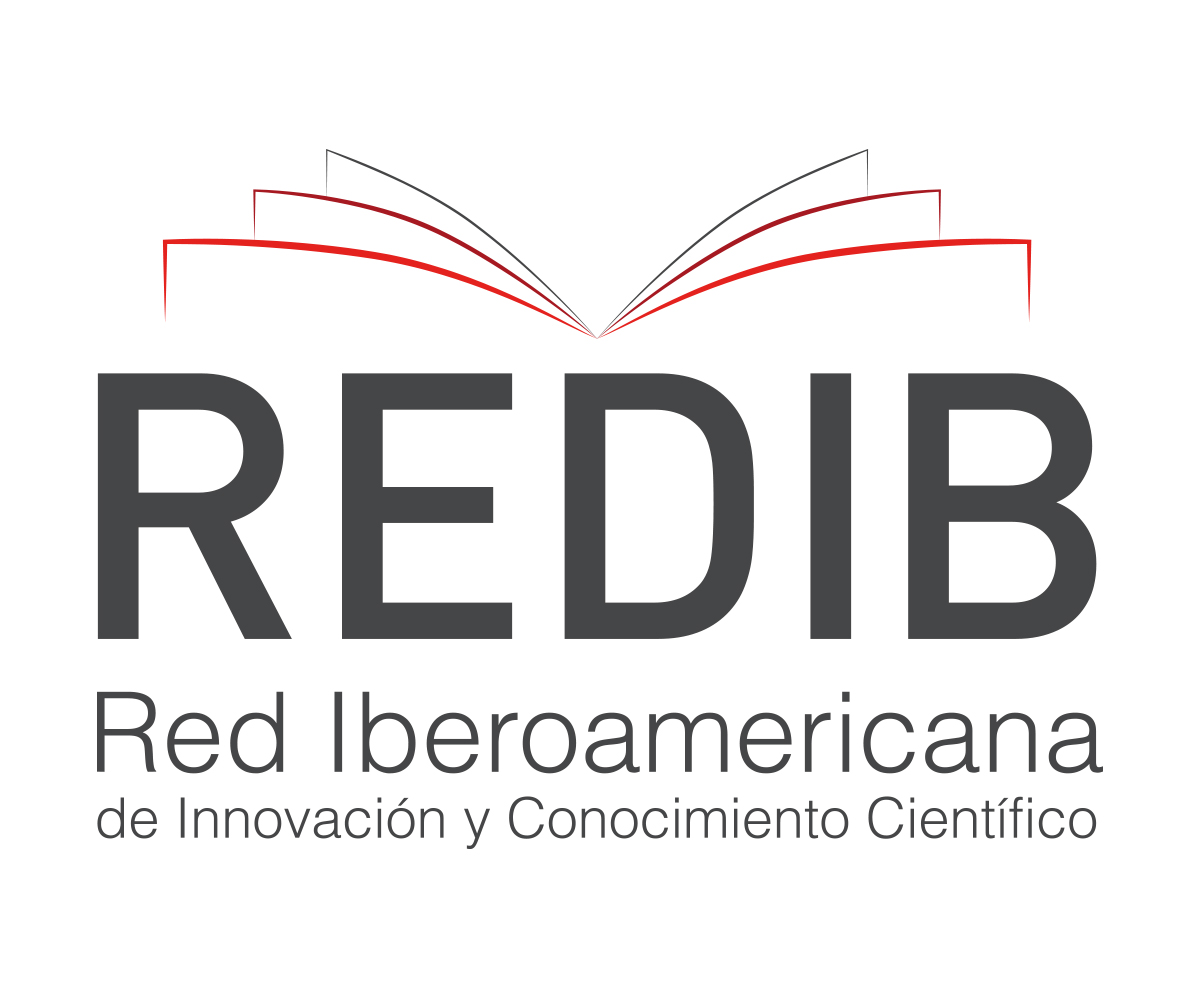Incidence of endoleak type IA in patients undergoing chimney endovascular aortic repair (ChEVAR) vs. standard endovascular repair
DOI:
https://doi.org/10.47487/apcyccv.v5i1.346Palabras clave:
Techniques, Endovascular, Endovascular Aortic Repair, Endoleak, FEVARResumen
Background. Almost half of endovascular aortic aneurysm repair (EVAR) procedures are performed in hostile anatomy, increasing the risk of procedure related complications such as type IA endoleaks, which may be prevented with the chimney technique in EVAR (ChEVAR). Objective: Our aim is to describe the differential characteristics between EVAR in favorable anatomy and ChEVAR in hostile necks. Materials and methods. A cohort of patients with infrarenal abdominal aortic aneurysms (AAA) that were treated with EVAR or ChEVAR were included. The primary outcome was the incidence of type IA endoleak. Secondary outcomes were the rate of chimney occlusion, reintervention, migration, rupture, acute limb ischemia, sac growth, and aneurysm- related mortality during the follow-up period. Results. With a median follow-up of 11.5 months, 79 patients were treated with EVAR and 21 with ChEVAR. The overall age was 76.49 ± 7.32 years old, and 82% were male. The ChEVAR cohort had a higher prevalence of tobacco use than the EVAR cohort (38.1% vs. 17.7%, p =0.041), and a shorter neck (7.88 mm ± 5.73 vs 36.28 mm ± 13.73, p<0.001). There were no differences in type IA endoleak incidence between the groups (a single endoleak type IA in the EVAR group, p = 0.309). One patient experienced an asymptomatic chimney occlusion in the ChEVAR group, and another patient required a reintervention due to chimney occlusion. Sac regression and reinterventions were not different between groups. There were no migration, rupture, acute limb ischemia, or aneurysm-related mortality events. Conclusions. In patients with abdominal aortic aneurysms, ChEVAR in hostile necks had similar event rates to EVAR in favorable necks.
Descargas
Referencias
Greenhalgh RM, Brown LC, Kwong GPS, Powell JT, Thompson SG, EVAR trial participants. Comparison of endovascular aneurysm repair with open repair in patients with abdominal aortic aneurysm (EVAR trial 1), 30-day operative mortality results: randomised controlled trial. Lancet Lond Engl. 2004;364(9437):843-8. doi: 10.1016/S0140- 6736(04)16979-1.
United Kingdom EVAR Trial Investigators, Greenhalgh RM, Brown LC, Powell JT, Thompson SG, Epstein D, et al. Endovascular versus open repair of abdominal aortic aneurysm. N Engl J Med. 2010;362(20):1863-71. doi: 10.1056/NEJMoa0909305.
Dillavou ED, Muluk SC, Rhee RY, Tzeng E, Woody JD, Gupta N, et al. Does hostile neck anatomy preclude successful endovascular aortic aneurysm repair? J Vasc Surg. 2003;38(4):657-63. doi: 10.1016/s0741- 5214(03)00738-9.
Walker J, Tucker LY, Goodney P, Candell L, Hua H, Okuhn S, et al. Adherence to endovascular aortic aneurysm repair device instructions for use guidelines has no impact on outcomes. J Vasc Surg. 2015;61(5):1151-9. doi: 10.1016/j.jvs.2014.12.053.
Herman CR, Charbonneau P, Hongku K, Dubois L, Hossain S, Lee K, et al. Any nonadherence to instructions for use predicts graft-related adverse events in patients undergoing elective endovascular aneurysm repair. J Vasc Surg. 2018;67(1):126-33. doi: 10.1016/j.jvs.2017.05.095.
Patel RP, Katsargyris A, Verhoeven ELG, Adam DJ, Hardman JA. Endovascular aortic aneurysm repair with chimney and snorkel grafts: indications, techniques and results. Cardiovasc Intervent Radiol. 2013;36(6):1443-51. doi: 10.1007/s00270-013-0648-5.
Bryce Y, Kim W, Katzen B, Benenati J, Samuels S. Outcomes over Time in Patients with Hostile Neck Anatomy Undergoing Endovascular Repair of Abdominal Aortic Aneurysm. J Vasc Interv Radiol JVIR. 2018;29(7):1011-6. doi: 10.1016/j.jvir.2018.03.002.
Wanhainen A, Verzini F, Van Herzeele I, Allaire E, Bown M, Cohnert T, et al. Editor’s Choice - European Society for Vascular Surgery (ESVS) 2019 Clinical Practice Guidelines on the Management of Abdominal Aorto-iliac Artery Aneurysms. Eur J Vasc Endovasc Surg Off J Eur Soc Vasc Surg. 2019;57(1):8-93. doi: 10.1016/j.ejvs.2018.09.020.
Chaikof EL, Dalman RL, Eskandari MK, Jackson BM, Lee WA, Mansour MA, et al. The Society for Vascular Surgery practice guidelines on the care of patients with an abdominal aortic aneurysm. J Vasc Surg. 2018;67(1):2-77.e2. doi: 10.1016/j.jvs.2017.10.044.
Patel R, Sweeting MJ, Powell JT, Greenhalgh RM, EVAR trial investigators. Endovascular versus open repair of abdominal aortic aneurysm in 15-years’ follow-up of the UK endovascular aneurysm repair trial 1 (EVAR trial 1): a randomised controlled trial. Lancet Lond Engl. 2016;388(10058):2366-74. doi: 10.1016/S0140-6736(16)31135-7.
Yo k o y a m a Y, K u n o T, Ta k a g i H . M e t a - a n a l y s i s o f p h a s e - s p e c i fi c s u r v i v a l a f t e r elective endovascular versus surgical repair of abdominal aortic aneurysm from randomized controlled trials and propensity score-matched studies. J Vasc Surg. 2020;72(4):1464-1472.e6. doi: 10.1016/j.jvs.2020.03.041.
Tan TW, Eslami M, Rybin D, Doros G, Zhang WW, Farber A. Outcomes of patients with type I endoleak at completion of endovascular abdominal aneurysm repair. J Vasc Surg. 2016;63(6):1420-7. doi: 10.1016/j.jvs.2016.01.027.
FransenGa.J,VallabhaneniSR,vanMarrewijkCJ,LaheijRJF,HarrisPL, Buth J, et al. Rupture of infra-renal aortic aneurysm after endovascular repair: a series from EUROSTAR registry. Eur J Vasc Endovasc Surg Off J Eur Soc Vasc Surg. 2003;26(5):487-93. doi: 10.1016/s1078- 5884(03)00350-2.
DonasKP,LeeJT,LachatM,TorselloG,VeithFJ,PERICLESinvestigators. Collected world experience about the performance of the snorkel/ chimney endovascular technique in the treatment of complex aortic pathologies: the PERICLES registry. Ann Surg. 2015;262(3):546-53; discussion 552-553. doi: 10.1097/SLA.0000000000001405.
Taneva GT, Lee JT, Tran K, Dalman R, Torsello G, Fazzini S, et al. Long-term chimney/snorkel endovascular aortic aneurysm repair experience for complex abdominal aortic pathologies within the PERICLES registry. J Vasc Surg. 2021;73(6):1942-9. doi: 10.1016/j. jvs.2020.10.086.
Donas KP, Torsello GB, Piccoli G, Pitoulias GA, Torsello GF, Bisdas T, et al. The PROTAGORAS study to evaluate the performance of the Endurant stent graft for patients with pararenal pathologic processes treated by the chimney/snorkel endovascular technique. J Vasc Surg. 2016;63(1):1-7. doi: 10.1016/j.jvs.2015.07.080.
Fazzini S, Martinelli O, Torsello G, Austermann M, Pipitone MD, Torsello GF, et al. The PROTAGORAS 2.0 Study to Identify Sizing and Planning Predictors for Optimal Outcomes in Abdominal Chimney Endovascular Procedures. Eur J Vasc Endovasc Surg Off J Eur Soc Vasc Surg. 2021;61(4):591-602. doi: 10.1016/j.ejvs.2020.11.019.
Ullery BW, Tran K, Itoga NK, Dalman RL, Lee JT. Natural history of gutter-related type Ia endoleaks after snorkel/chimney endovascular aneurysm repair. J Vasc Surg. 2017;65(4):981-90. doi: 10.1016/j. jvs.2016.10.085.
Katsargyris A, Oikonomou K, Klonaris C, Töpel I, Verhoeven ELG. Comparison of outcomes with open, fenestrated, and chimney graft repair of juxtarenal aneurysms: are we ready for a paradigm shift? J Endovasc Ther Off J Int Soc Endovasc Spec. 2013;20(2):159-69. doi: 10.1583/1545-1550-20.2.159.
Donas KP, Torsello G, Bisdas T, Osada N, Schönefeld E, Pitoulias GA. Early outcomes for fenestrated and chimney endografts in the treatment of pararenal aortic pathologies are not significantly different: a systematic review with pooled data analysis. J Endovasc Ther Off J Int Soc Endovasc Spec. 2012;19(6):723-8. doi: 10.1583/ JEVT-12-3952MR.1.
Mathlouthi A, Locham S, Dakour-Aridi H, Black JH, Malas MB. Impact of suprarenal neck angulation on endovascular aneurysm repair outcomes. J Vasc Surg. 2020;71(6):1900-6. doi: 10.1016/j. jvs.2019.08.250.

Descargas
Publicado
Número
Sección
Licencia
Derechos de autor 2024 La revista es titular de la primera publicación, luego el autor dando crédito a la primera publicación.

Esta obra está bajo una licencia internacional Creative Commons Atribución 4.0.

















